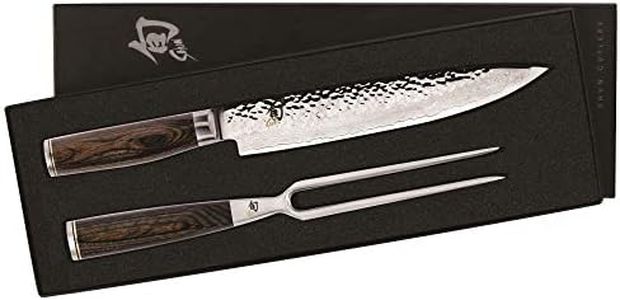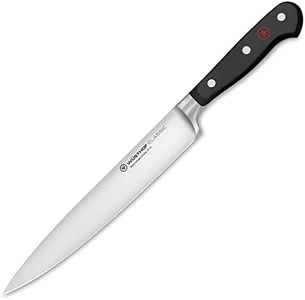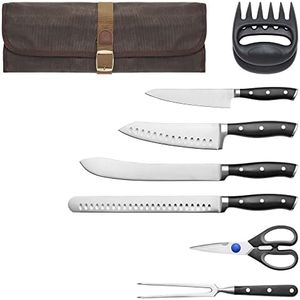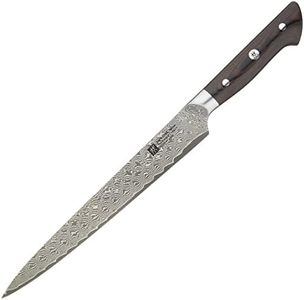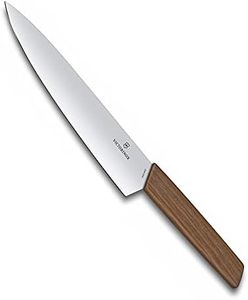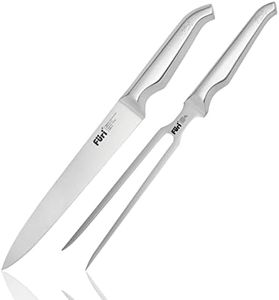We Use CookiesWe use cookies to enhance the security, performance,
functionality and for analytical and promotional activities. By continuing to browse this site you
are agreeing to our privacy policy
10 Best Carving Knives
From leading brands and best sellers available on the web.Buying Guide for the Best Carving Knives
Choosing a carving knife can feel overwhelming with the variety of shapes, sizes, and features available. The right carving knife makes slicing meats, poultry, and even some fruits easier and more precise, turning a frustrating task into an enjoyable one. Your specific needs—such as the size of roasts you carve, how often you cook, and your grip comfort—should guide your choice. By understanding the key features, you can find a carving knife that feels right in your hand and performs beautifully in your kitchen.Blade LengthBlade length refers to how long the cutting part of the knife is, usually measured in inches. It's important because a longer blade makes it easier to slice through larger cuts of meat, like turkey or roast beef, in a single smooth motion. Carving knife blades generally range from 7 to 14 inches. Shorter blades (around 7-9 inches) are good for small items like chicken breasts, while longer blades (10-14 inches) excel at large roasts. To pick the best length, consider what you'll carve most often: go longer for big meats, and shorter for versatility in a small kitchen.
Blade FlexibilityBlade flexibility is about how much the knife bends when you press on it. A more flexible blade can help with delicate, thin slicing, while a stiffer blade offers control for firmer foods. Carving knives tend to be somewhat flexible, but not as much as fillet knives. If you primarily carve tender meats or fish, a bit more flexibility is helpful, but if you're slicing denser roasts, choose a stiffer blade for better stability.
Blade MaterialThe blade material affects sharpness, durability, and maintenance. Most carving blades are stainless steel, resisting rust and easy to care for, but carbon steel can provide a sharper edge for longer at the cost of some extra upkeep. If you want easy care, choose stainless steel. If you value long-lasting sharpness and don’t mind occasional oiling and prompt drying, carbon steel may suit you.
Blade EdgeCarving knives come with either a straight (smooth) edge or a Granton (hollow) edge which has small dimples along the blade. A straight edge is suitable for smooth, clean slices, while the Granton edge helps reduce friction and prevents thin slices from sticking to the knife. If you often carve large, juicy roasts or want paper-thin slices, the Granton edge makes life easier. For general use, a straight edge will be more than sufficient.
Handle Comfort and MaterialHandle comfort and material are vital for grip and safety, especially during longer carving sessions. Handles may be made of wood, plastic, or composite materials—each offering different textures and weights. Ergonomic handles with curves fit the hand more naturally and help prevent slipping. If you have smaller hands or arthritis, look for a handle that is comfortable and not too heavy. It’s always a good idea to hold a few knives if possible and see which feels secure and balanced in your hand.
Weight and BalanceThe right weight and balance makes the knife easier to control, reducing fatigue and improving safety. A knife that's too heavy may cause wrist strain, while an overly light knife might not offer the power needed for tough cuts. The best choice is a knife that feels balanced when you grip it at the bolster (the area where blade meets handle). If the blade or handle feels too dominant, try another style until you find one that feels like a natural extension of your arm.

